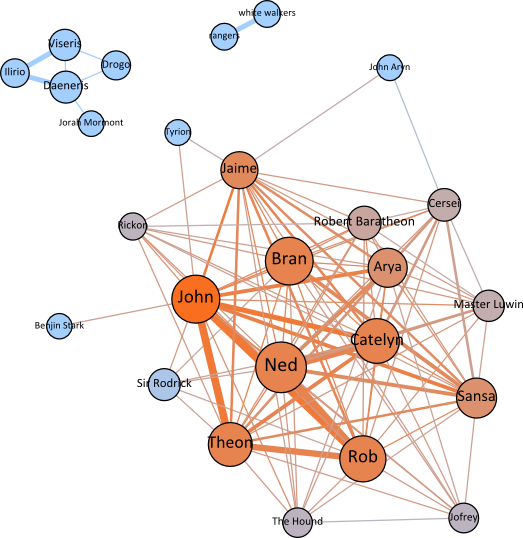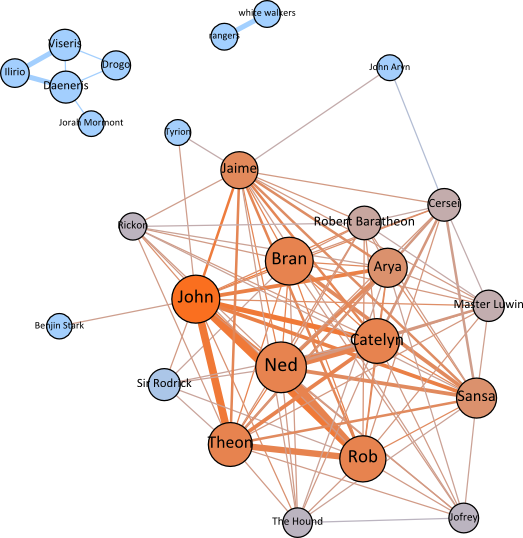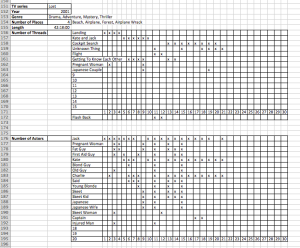In the past 20 years, television storytelling has changed drastically. First we had traditional episodic and serial forms of television and then they turned into more complex narrative forms, changing our TV perception. In our research project, we wanted to tackle this idea of narrative complexity in TV series. In the past years new techniques of directing and producing of motion pictures were introduced. Having that in mind, we wanted to find out if narrative complexity has changed over the last 20 years. Another thing we were thinking of is what factors would effectively influence narrative complexity in TV series. Since genre roughly classifies movies and TV series and therefore determines the form and style of TV series, our second research task was to discover if the narrative complexity varies based on the genre. In order to find out if there is a correlation between complexity of TV series and its popularity, we did a research to find out if more people tend to watch more complex and elaborate series, or if the majority prefers simple forms of entertainment, i.e. if they prefer a series that doesn’t require them to watch every single episode to understand it. In order to answer our research questions mentioned above, we chose 20 representative TV shows released in the last 20 years. With this selection, we also covered a wide range of genres. As the first episode usually represents the whole TV show very well, we decided to watch only the first episode of each series in order cover more series in the given time. To measure complexity, we focused on the following factors: number of narrative threads, average number of narrative threads running in parallel, number of places as well as number of characters and average number of characters showing in the same time within an episode. By introducing a form, every team member followed given instructions and could work on his own in the data gathering. The form was filled out as shown in fig. 1, where the numbers for each time frame denote the thread number, in which that person appears.

Fig. 1: Data Gathering form for number of places, threads and actors. Numbers in the actors list indicate the presence of a character in a specific thread for every time frame.
Number of appearing flash backs and the consideration of different length of one episode was neglected on purpose not to have too many factors and facilitate the processing step. Given the data, we could determine the number of places, threads and actors in one episode. By dividing the actual number of threads and actors by the sum of all threads and actors for every series, we got the average number of threads and actors that run and appear at the same time, which gave us another two important factors to express narrative complexity. To make series comparable with each other, every factor is normalized by dividing it by the maximum of each column (eg. number of places is divided by the maximum value of all series). The complexity of each episode is then calculated as the sum of equally weighted factors (which could be optimized, but represent complexity very well). In order to address the third question, we used IMDB ratings and compared them with the calculated complexity.

Fig. 3: Normalized and averaged complexity of all TV series over the last 20 years. Series released in the same year are averaged.
By plotting the averaged overall complexity of all series against time (fig. 3), the same trend is visible. The black line represents the linear regression of the data. Given these first results, we can confirm the tendency of an increase in narrative complexity in TV series over the past 20 years. To answer the second research question, we classified all 20 series into five genres. This classification has been carried out with consideration of online data bases as well as our own opinion.
We plotted four typical TV series representing four different genres (fig. 4), but that were released at the same time (between 2004 and 2005). The result shows, that sitcoms seem to have a low complexity in comparison to the other genres. By calculating the mean of all genres (even though we’ve seen before, the release date of a TV series seems to have an influence on the complexity) and the mean of all sitcom series, one obtains the graph in fig. 5.

Fig. 5: Average complexity of the sitcom TV series (left) and all other genres (rest). The standard deviation is shown in black bars.
It can be concluded, that sitcoms show a less complex narrative style than other genres. This was expected and more or less obvious. But it also shows that our chosen process of data gathering and processing is right. Interestingly, sitcoms show the lowest standard deviation (black error bars) of all genres. This tells us, that sitcoms have not strongly changed in the last 20 years. Fig. 6 shows the averaged complexity values for all genres. Soap operas and action series show the highest complexity. It is to mention that these results may change considerably by using data of additional TV series.
To answer the last research question, the ratings of internet databases was compared with the complexity values for each series. For this, IMDB seemed to be the most appropriate data base, as there are thousands of people rating all kind of TV series. However, one has to keep in mind, that older TV series by trend show slightly lower values as not that many people know these series and new series seem to have a positive effect on the watcher.
Fig. 7 shows the averaged ratings of all TV series per genre. Interestingly, the graph shows the same trend as the comparison of the genres by their averaged complexity. By plotting the complexity of each series against the rating in fig. 8, we observe a slight correlation, which is not outstanding though.
Finally we can conclude that narrative complexity in TV series increased over the past 20 years, complexity differs from genre to another and TV series with higher complexity tend to get higher ratings. In order to make more exact statements with certainty, further data gathering would be required and exceeds the available time of this project. The second part of our project was to visualize narrative complexity. Two methods were chosen in that purpose: narrative threads and graphs showing interactions between characters.
We felt that one of the most interesting aspects of a TV series are the characters, the way they develop, and most importantly, the connections that establish between them. Over a large number of episodes, viewers get familiar and even attached to the characters, this being one of the factors that keeps them hooked. We constructed a polymetric visualization of the characters in an episode in order to get an overview of the episode and its characters. The size of the node is the weighted degree and the color of the node, the eigenvector centrality. We were inspired by the work done by the people behind moviegalaxies, and so we have contacted them do discuss their method; we’ve taken it and adapted it to our needs.
The important thing that this visualization brings is the fact that we are able to summarize a whole episode, one might argue that even a whole series, with just one picture. We see the interaction between characters, the clusters that are being formed. These clusters of characters are exactly the ones that are going to be the main protagonists in each narrative thread we have identified. In more complex TV series, such as Game of Thrones we can see that there are multiple clusters, in this particular case, they are not even connected; the characters don’t even meet for the entire series, they only know about each others existence and influence themselves indirectly.
Using this technique, we were able to spot patterns among different series, especially for sitcoms. For these, there is a small group of core characters and only one or two secondary characters which appear briefly and don’t have an impact on the plot. The graphs speak for themselves, showing the simplicity of the series (Big bang theory, Friends, How I met your mother and Two and a half men).
Another notable observation can be made about Desperate Housewives: here we have a unique way of story telling by creator Marc Cherry. The story is always divided into 4 parts, one for each of the main protagonists (Bree, Gabrielle, Lynette and Susan), which later intertwine and evolve into a more complex plot. Besides their friendship, the common connection they share is the murdered Mary Alice, we can see, acts as the bridge between the three smaller clusters which represent their families. Because in this episode, Gabrielle and Bree were most of the time together, we see that their families form a single cluster. This later fact suggests one of the limitations of our approach: the data on which we are performing the analysis is sometimes too small. In the future, we plan to extend to a larger number of episodes for each series.
Another pattern we see in a lot of TV series, especially, in the not so complex ones, is that of one main character and other secondary ones which gravitate around the first. He or she is the star of the show, present in all the narrative threads and connected with every other character.
Based on these findings we conclude that this visualization technique proved to be very useful. It allowed us to easily grasp a lot of information about all the 20 series and more importantly it allowed us to compare them, to find similarities and recurring pasterns. We were able to see things that otherwise would have required complex statistical investigations and inspiration because, a picture is worth more than words. These graphs have helped set us on the right track and served as support during our statistical investigation.
We have also been able to identify some limitations of this technique and a couple of directions for further improvement. In some cases we were affected by the fact that we only analyzed one episode of each series. While we believe that each episode, especially the first one, is very representative for a successful TV series, one without a powerful motivation to change, we acknowledge the fact that there might still be some undiscovered or unrepresented connections between characters. For example, in the case of Oz, the main character in the episode, Dino Ortolani, dies and the subsequent episodes will have different main characters. This information couldn’t be uncovered through viewing only one episode. However, these type of cases are rare, and generally, the findings we’ve obtained are correct (validated through viewing more episodes of the series).
One of the directions of improvement would be to add a dynamic component to the visualization, specifically, to track the evolution of the graph over more episodes. In this way we can see the dynamics between the characters, the forming and breaking of relationships and how these evolve over time. This technique has been applied, with success, by the people behind movie galaxies, where they can see the evolution of characters within a movie. This helped identify various patterns, one of the most famous being the one of Quentin Tarantino who always kills a lot of his characters and new ones appear in the final part of the movie. We believe that applied in the context of TV series, this can provide even more interesting insights.















